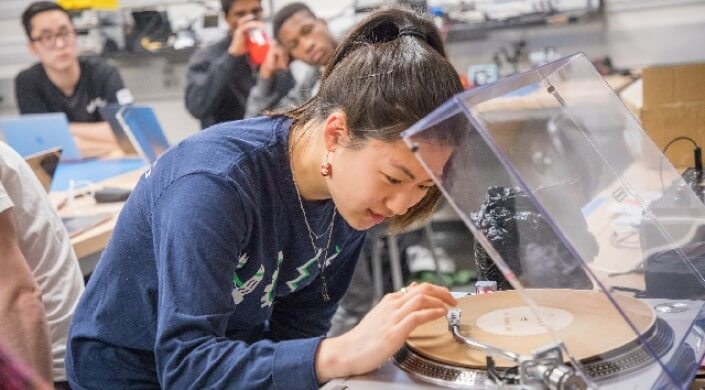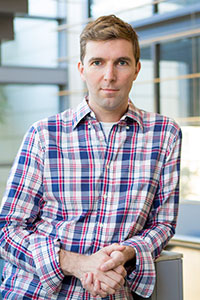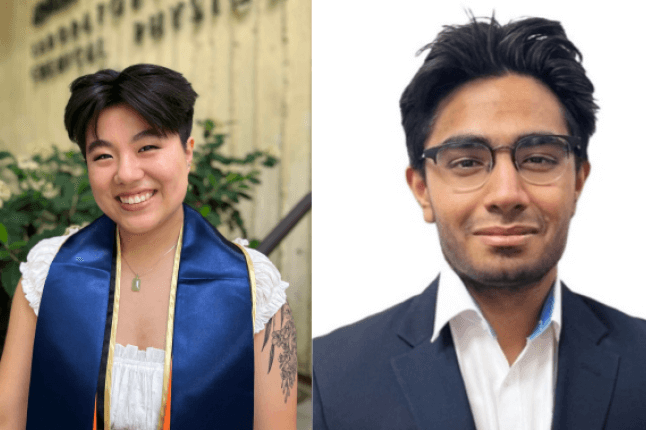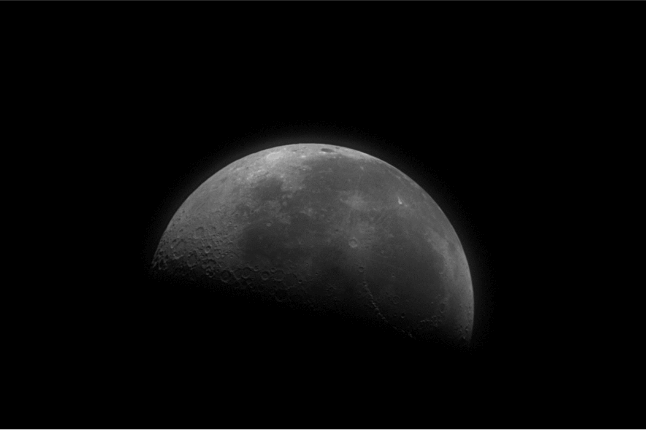News
Jessica Han, A.B. ’20, a computer science concentrator, carefully sets a laser-cut record onto the record player during a lab for Engineering the Acoustical World (ES 25). (Photo by Eliza Grinnell/SEAS Communications)
The students grimaced as the volume of the high-pitched wail intensified to near ear-pounding proportions. Eyes narrowed, they gazed towards the front of the classroom, where an instructor cranked up the volume. With a sudden “clink” the wine glass they were staring at shattered, raining jagged pieces onto the table. The room erupted with laughter and applause.
That scene introduced a lecture on resonance and transduction in the new Harvard John A. Paulson School of Engineering and Applied Sciences (SEAS) course Engineering the Acoustical World (ES 25), taught by Rob Wood, Charles River Professor of Engineering and Applied Sciences. The course uses music and musical instruments to introduce a broad array of concepts in physics, mathematics, and engineering to students from both technical and non-technical backgrounds.
The course was made possible by the SEAS Learning Incubator (LInc), and is supported by preceptor Salma Abu Ayyash, Maddie Hickman, Specialist in Mechanical Engineering in the Active Learning Labs, Jim MacArthur, SEAS/Physics Electronics Shop Manager and Instructor, and collaborators in the Department of Music.
“Consider any instrument, any piece of music, or any historical music period—chances are we can find a mathematical concept or mechanical engineering principle to shed some light on it,” Wood said. “Take the vibrations of a string on a guitar, or the signal processing techniques involved in an electronic effect—you can go as shallow or as deep as you want, but everything you listen to has something you can tie to an engineering concept.”
After the wineglass was shattered, the remainder of the lecture featured a reharmonization of chords in a Bach concerto using a sustain pedal on an electric keyboard to simulate reverberation. The class concluded with Wood plugging in his electric guitar to demonstrate how pickups work (they are transducers that convert string vibrations into an electrical signal). Rather than relying on an example from a dusty physics tome, Wood cited the work of Pink Floyd guitarist David Gilmour.
Using these kinds of examples, the course covers a wide range of musical concepts and their scientific and historical underpinnings—from the evolution of Western scales, to the mechanics of musical instruments, such as vibration modes of a drum, to the physics of room acoustics, to electrical engineering principles involved in transducing a signal so it can be played through a speaker.
Students perform hands-on lab work in lieu of traditional tests to learn the concepts, Wood explained.
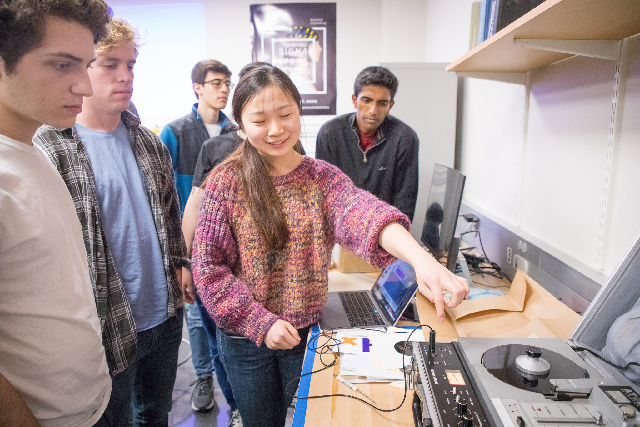
Teaching fellow Anqi Chen demonstrates how to record a song onto a 45, using Nirvana's iconic grunge song "Smells Like Teen Spirit" as an example. (Photo by Eliza Grinnell/SEAS Communications.)
In one lab, students learned about different methods to cut vinyl records—gaining experience with laser cutting, 3D printing, and lathe cutting—and watched as teaching fellow Anqi Chen, an applied physics Ph.D. candidate, recorded Nirvana’s “Smells Like Teen Spirit” onto a blank 45. As the vibrating needle cut the iconic grunge song into the smooth record, she wiped away tiny ribbons of vinyl that peeled off the surface.
Student Jess Han carefully set the freshly cut 45 onto a record player, and the class cheered as the raucous opening chords exploded out of the speakers.
Han, A.B. ’20, a computer science concentrator, opted to take ES 25 because of its hands-on nature.
“I was drawn to the opportunities to explore sound-based engineering in this course,” she said. “I’ve always had an interest in building a speaker, and I wanted to get the background knowledge and experience to do that project.”
Her favorite lab challenged students to build their own instruments. Han and her teammate produced an ocarina, and were surprised by how much math went into something so simple. The holes had to have very precise circumferences to generate the right notes.
Ashwin Krishna, A.B. ’20, an applied math concentrator, and his partner, crafted a combination guitar/violin.
“This class has really opened me up to all the different ways that music and engineering intersect,” said Krishna, himself a classical guitarist. “We’ve spent a lot of time learning about the physics of sound and music, and it has really been eye-opening.”
For his final project, Krishna found a musical application for some of his favorite techniques from computer science. He is using deep learning to create a neural network that can learn to compose Bach-style concertos by itself.
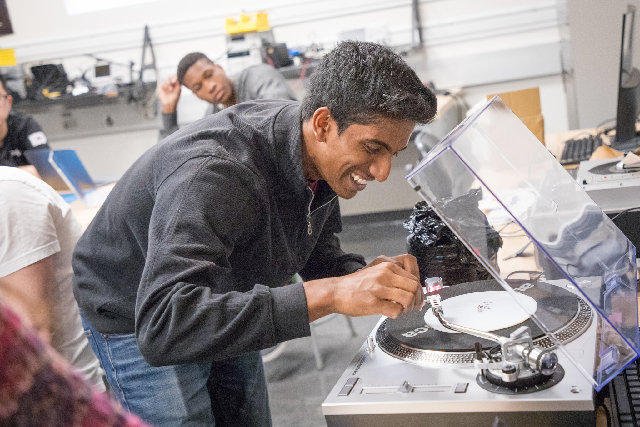
Applied math concentrator Ashwin Krishna, A.B. '20, experiments with the record player. (Photo by Eliza Grinnell/SEAS Communications)
Also a musician, Milan Ravenell took the course because he wanted to revisit some of the lessons he learned while playing saxophone in high school.
While some of the mathematical and engineering concepts had a steeper learning curve than others, Ravenell, A.B. ’18, a computer science concentrator, enjoyed exploring the practical applications.
“It has been good for me to get a behind-the-scenes look at things that I always thought were really common, like electric guitars,” he said. “Even the amount of engineering that goes into seemingly simple things, like microphones and speakers, was surprising to me. These are not as complicated as some pieces of equipment, but they are still brilliant feats of engineering.”
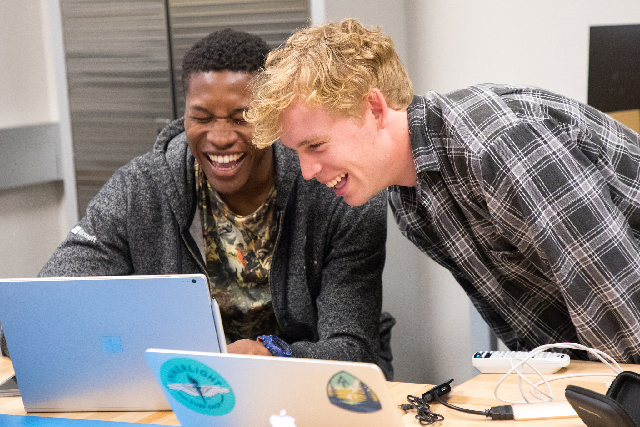
Milan Ravenell (left), A.B. ’18, a computer science concentrator, and one of his fellow students in ES 25, laugh as they listen to their own compositions. (Photo by Eliza Grinnell/SEAS Communications)
For Wood, the course is a perfect combination of his passions. He has played guitar as a hobby for decades, and his interest in taking them apart to uncover how they worked helped inspire him to become an engineer.
He hopes ES 25 students acquire a similar fascination for the engineering concepts underlying the music pouring out of their ear buds every day.
“What I really want them to walk away with is confidence in some of the engineering topics we cover,” he said. “I want to demystify these topics, but also remove what could be the intimidation factor in learning about complex systems and engineering approaches and analysis.”
Engineering the Acoustical World (ES 25) will be taught again in the fall, 2018 term. See courses.my.harvard.edu for more information.
Engineering the Acoustical World (ES 25) will be taught again in the fall, 2018 term. See courses.my.harvard.edu for more information.
Banana Piano
Listen as senior Aron Szanto, an applied math concentrator, plays a jazzy tune on a capacitive banana piano he developed for Engineering the Acoustical World (ES 25). (Video by Maddie Hickman)
Topics: Applied Physics
Cutting-edge science delivered direct to your inbox.
Join the Harvard SEAS mailing list.
Scientist Profiles
Robert J. Wood
Harry Lewis and Marlyn McGrath Professor of Engineering and Applied Sciences
Press Contact
Adam Zewe | 617-496-5878 | azewe@seas.harvard.edu
